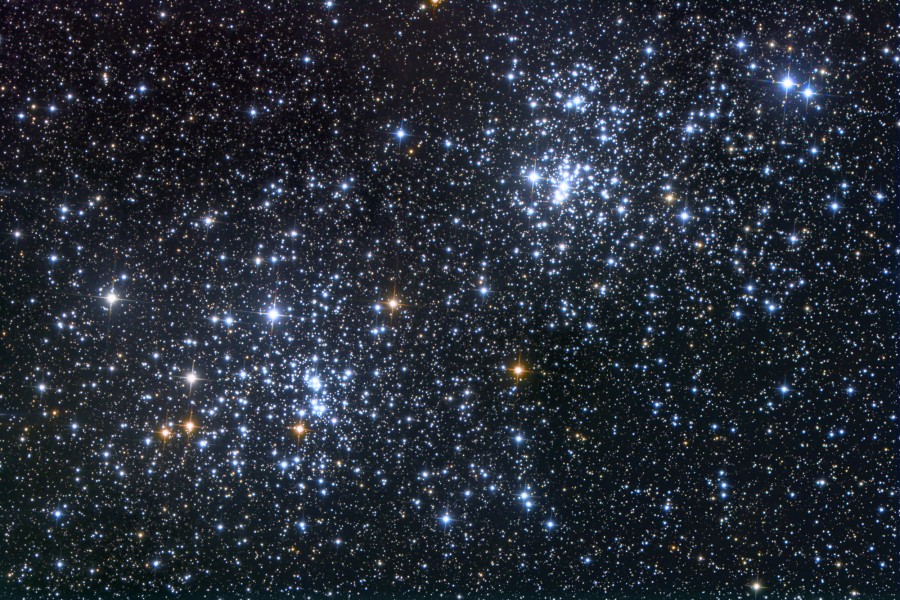I like today's APOD, but because it is so large that I can only post it as an attachment, and since I have other attachments to post, I will post two much smaller pictures of Caroline's Rose that I found on the net.
As you can see, Caroline's Rose cluster appears to be quite rich and contain many member stars. But the stars are mostly faint, so the cluster doesn't stand out that clearly against the background. In the Wikisky image you can see that all the brightest stars are red, but the red giant stars are not that much brighter than their cluster siblings, which means that the red giant stars are not extremely bright in themselves.
All of this, taken together, suggests that NGC 7789 is somewhat old-ish. And yes, 1.6 billion years is actually somewhat old for an open cluster.
So let's compare Caroline's Rose with other rich open clusters of different ages! Let's start with a cluster that is older than Caroline's Rose:
According to
Wikipedia, NGC 2158 is believed to be 2 billion years old. You can see that it is very rich, much richer than Caroline's Rose. You can also see that the brightest stars of NGC 2158 are red giants that seem to stand out more in brightness than the brightest stars of Caroline's Rose. A word of caution, though: The NGC 2158 image is an SDSS one, and SDSS tends to "exaggerate" the brightness of the reddest stars. (To be more precise, the SDSS channel that is mapped as red is actually an infrared one, and since the reddest stars are typically very infrared, they do look extra bright in SDSS images.)
You can see small blue stars scattered in NGC 2158. According to
this source, NGC 2158 is a metal-poor cluster, which could mean, theoretically, that the small blue stars could be blue horizontal branch stars similar to the blue stars of globular clusters. But I doubt it. In my opinion, the small blue stars of NGC 2158 could be early F-type stars or blue stragglers that have gained mass from another star and become hotter. (The bright blue star at lower left that appears to be a member of NGC 2158 is almost certainly a foreground star and an outlier of cluster M35.)
A rich cluster that is young is M11, the Wild Duck Cluster, in Scutum.
M11, the Wild Duck Cluster. Credit: ESO.
M11 is believed to be 316 million years old, according to
Wikipedia. (Don't ask me how they know it's not 315 or 317 million years old instead.

)
As you can see, M11 is rich, and most of the brightest stars are blue. However, there are many red giant stars in M11 too. The blue stars of M11 are most likely spectral class A, and the blue giants may also typically be spectral class A. Neither the red giants nor the blue giants of M11 are supergiants.
A cluster than is about the same age as M11 is NGC 3532. In a brilliant picture by Velimir Popov and Emil Ivanov, you can really see the mixture of red and blue stars in a rich cluster of this age:
Much younger than M11 and NGC 3532 are the
Double Cluster in Perseus:
The stars of the Double Cluster of Perseus are believed to be only 14 million years old. As you can see, most of the brightest stars are blue, but there are five prominent red giant stars. Or, correction, these red stars are not mere giants but supergiants, as are the brightest blue stars of the clusters. The brightest blue and red stars of the Double Cluster of Perseus are much more massive than any stars found in M11, NGC 3532, NGC 2158 or Caroline's Rose.
Let's take a look at an even younger cluster:
NGC 6231. Credit: Josef Pöpsel, Stefan Binneweis/ Capella Obersvatory
is believed to be only 2-7 million years old. All its brightest stars are blue, and it contains no red giant stars at all. The bright yellow star at upper left is a foreground star, as is the small very red star at lower right. If you ask me, an age of 2 million years seems more reasonable than 7 million years, because I suspect that at least one of the massive blue stars of this cluster would have run out of its core fuel and turned into a red supergiant if it was 7 million years old.
Let me finish by showing you a picture of open cluster Trumpler 5:
Trumpler 5. Credit: Photocommunity Deutschland.
So, based on the appearance of this cluster, how old do you think it is? It's extremely hard (or impossible) to judge Trumpler 5's exact age from its appearance, but what do you think?
(I guess you can cheat if you want and google it!) 
Ann
EDIT: Okay! I couldn't help myself. I googled "Trumpler 5 age" and got a few different answers, among them Log Age, 9.61. (What does that mean, Chris? I have an idea, but I think that would perhaps make the cluster too old.)
Another answer to the age of Trumpler 5 was
125 million years. That is dead wrong! Okay, fellow Starshippers and Asteriskers, can you tell me why that age is dead wrong for Trumpler 5?
 NGC 7789: Caroline's Rose
NGC 7789: Caroline's Rose






